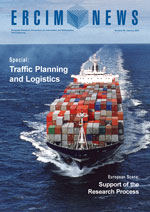by Anthony Savidis and Norbert Streitz
The recently formed Working Group SESAMI focuses on research towards distributing, embedding, coordinating and interactively delivering computing intelligence, while putting people and social contexts at the centre of design considerations. This will result in smart surrounding environments and ubiquitous intelligence.
Ambient intelligence represents a vision of the near future in which 'intelligent' or 'smart' environments and systems react in an attentive, adaptive, and active (sometimes even proactive) way to the presence and activities of humans and objects in order to provide intelligent/smart services to the inhabitants of these environments.
Ambient intelligence technology integrates sensing capabilities, processing power, reasoning mechanisms, networking facilities, applications and services, digital content, and actuating capabilities distributed in the surrounding environment. While a wide variety of technology is involved, the goal of ambient intelligence is to hide its presence from users by providing implicit, unobtrusive interaction paradigms. People and their social situations, ranging from individuals to groups, be they work groups, families or friends and their corresponding environments (office buildings, homes, public spaces etc), are at the centre of the design.
The scope of the ERCIM Working Group SESAMI includes the facilitation of collaborations in this area, on the grounds of on going, potentially cross-domain, basic and applied research and development. In this context, SESAMI will pursue novel insights on designing, implementing, managing and maintaining smart computational environments on any scale. This will enable to enhance and go beyond traditional computational support of human activities for any given situation, context or role.
Background
Ambient intelligence and smart environments represent an emerging field of research and development that is rapidly gaining attention from an increasing number of researchers and practitioners worldwide. There are several reasons for this.
Ambient intelligence brings a special perspective to research associated with technical fields such as ubiquitous computing, pervasive and proactive computing, ambient computing, embedded computing and smart objects. In addition, the notion of ambient intelligence is becoming a de facto key dimension of the emerging Information Society, since many next-generation industrial digital products and services are shifting towards a smart computing environment.
Focus of Thematic Areas
Work related to ambient intelligence is concerned with modelling and supporting people and their activities, sensing and locating people and objects, managing and interpreting contexts, providing awareness and notification, and enabling people to interact naturally and intuitively with their environments via multiple modalities and coupled devices. Additionally, a key issue regarding smart environments is the delivery of extensible infrastructures with varying intelligent computational resources exploiting underlying information sources, corresponding software platforms and architectures able to provide and handle intelligent services. The orchestration and integration of computational elements that comprise distributed applications serving multiple users, both mobile and stationary, is another important aspect of ambient intelligence. Relevant applications are expected to provide value-added services via smart artefacts that are smoothly integrated with the surrounding environment and can also be accessed remotely in distributed environments.
Potential thematic topics of the SESAMI Working Group include, but are not limited to, the following:
-
modelling and support of human activity
-
context models, management and interpretation
-
sensing paradigms and technology
-
awareness and notification
-
tangible, multimodal and implicit interaction
-
universal access
-
mobile and stationary artefacts
-
distribution and orchestration
-
service infrastructures
-
multimedia and adaptation
-
coordination and collaboration
-
social aspects, reflecting the 'human in the loop'
-
security and privacy
-
applications, eg office/work, home, public spaces, health care, education and leisure/entertainment.
Current Activities
Two special thematic sessions are to be held as part of the 4th International Conference for Universal Access in Human Computer Interaction (UAHCI), jointly with the 12th International Conference on Human-Computer Interaction, on 22-27 July 2007 in Beijing, China (http://www.hcii2007.org/). These are SESAMI-I: Interaction Design and Evaluation, chaired by Norbert Streitz, and SESAMI-II: Tools, Architectures and Infrastructures, chaired by Anthony Savidis. An open call for papers has been made for both sessions, resulting in a total of fourteen accepted papers, with seven per session. All papers will be published as part of the Springer LNCS proceedings of the UAHCI 2007 conference.
A Special Theme issue will be published by Elsevier in their international, refereed, interdisciplinary journal 'Interacting with Computers' (IwC). The issue is entitled 'Interaction in Ambient Intelligence: Methods, Tools and Applications' and is guest-edited by Anthony Savidis, Norbert Streitz, Carsten Magerkurth and Constantine Stephanidis. The selection process for the papers has been initiated by the guest editors.
Link:
http://www.ics.forth.gr/sesami
Please contact:
Anthony Savidis, SESAMI Chair, ICS-FORTH, Greece
Tel. +30-2810-391749
E- mail: as![]() ics.forth.gr
ics.forth.gr
Norbert Streitz, SESAMI Co-Chair
Fraunhofer IPSI, Germany
Tel: +49 6151 869-919
E-mail: streitz![]() ipsi.fraunhofer.de
ipsi.fraunhofer.de










